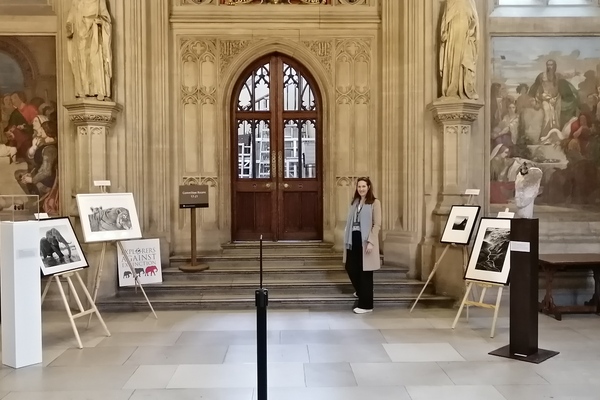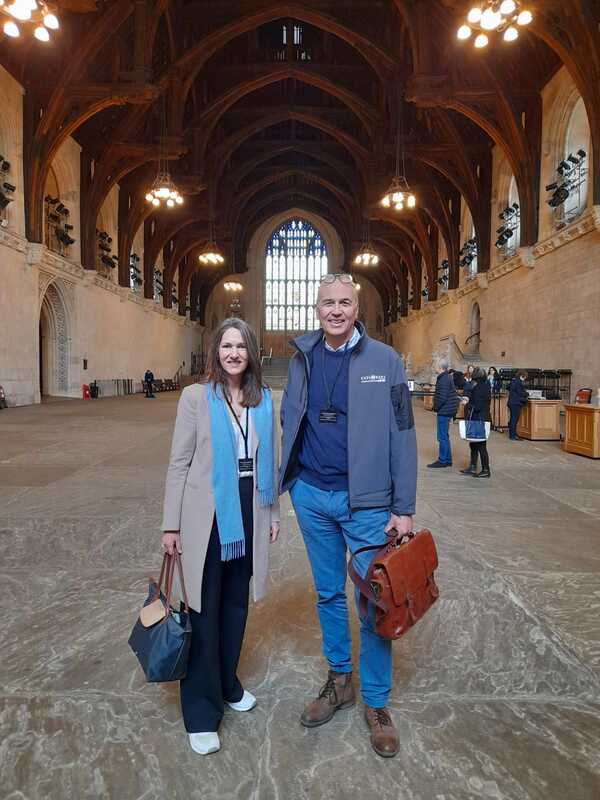
Rob & I are just back from a week in Westminster. We had a very interesting week, met a lot of people including MPs, Peers, Parliamentary staff and their guests, with many positive as well as some challenging conversations. Overall, it was a fantastic opportunity and the week provided a fascinating insight into life at Westminster.
The preview week also provided invaluable feedback about the collection and how it commuicates the central themes of time and loss . The Upper Waiting Hall provided a spectacular setting. We have returned to Norfolk with a few ideas about how we can further enhance the public exhibition tour, which follows later this year.
You can find out more about The Extinction Collection on our website here>>>
If you've never been inside Westminster and are curious ... then read our Insider's Guide below!
With special thanks to Duncan Baker, MP for North Norfolk, for supporting the exhibition and hosting our opening event.
Image: Rob & Sara in Westminster Hall
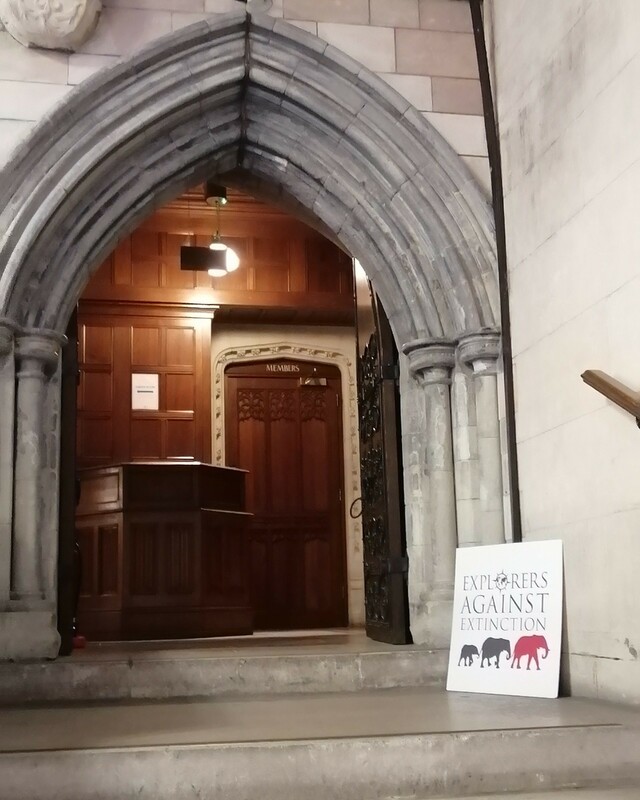
Insider's Guide to Westminster
The Parliamentary Estate is vast and we only got to see a tiny part of it during our week thanks to a couple of friends who work there and could take us to areas only accessible to passholders and their guests.
Did you know there's a hair salon, a pub, an underground walkway from Westminster to Portcullis House and that they serve fishfinger buttys (with lemon mayo) in the Lord's cafe?
Wherever you are in Westminster you will see 2 television screens - one is green for the Commons and one red for the Lords. These screens provide detailed up-to-the-minute information. When we were there the Rwanda bill was being debated, among other things.
You also hear a lot - loud debate and clapping from the Chamber or Committee rooms at times, and the constant ringing of the 'Division Bell' - on hearing the bell, members have eight minutes to cast their vote for or against the given motion.

Westminster Hall & The Chapel of St Mary Undercroft
When visitors arrive at the Cromwell Green entrance and go through security checks they eventually arrive at the entrance to the impressive Westminster Hall, a huge medieval hall dating to 1097, built under William II (Rufus), the son of William the Conqueror.
Over 900 years of history really hits you, as does the cold air, when you walk across the giant Yorkstone floor and look up at the hammerbeam roof.
Many people will instantly recognise the hall because Queen Elizabeth II lay in state here in September 2022 but over the years it has been at the centre of many important events.
Coronation banquets, and trials during the English Civil War took place here. It suffered damage from bombing raids during the Blitz and has hosted world leaders including Nelson Mandela in 1996, Barack Obama in 2011 and Volodymyr Zelenskyy in 2023.
If absorbing all that history is a bit much for you, you may want to detour to the Jubilee Cafe. The cafe is lovely and warm, unlike the rest of the Palace. It offers a small selection of sandwiches/paninis @ £4.85 each, and lots of yummy cakes at £3.60 a pop. A cuppa will cost you £2.35. Not your average meal deal but very convenient.
There is also a small gift shop, washrooms and steps up to some of the meeting/entertaining rooms from Westminster Hall.
In the far left corner of the hall is the entrance to The Chapel of St Mary Undercroft completed by King Edward I in 1297, and restored by Charles Barry in the 1860s.
The Chapel is open to passholders and accessed by a flight of stairs. We were lucky to be shown around, including the famous broom cupboard where the suffragette Emily Davison hid in 1911, the night before the census (so she could have her registered address down as Westminster).
Image: Chapel of St Mary Undercroft
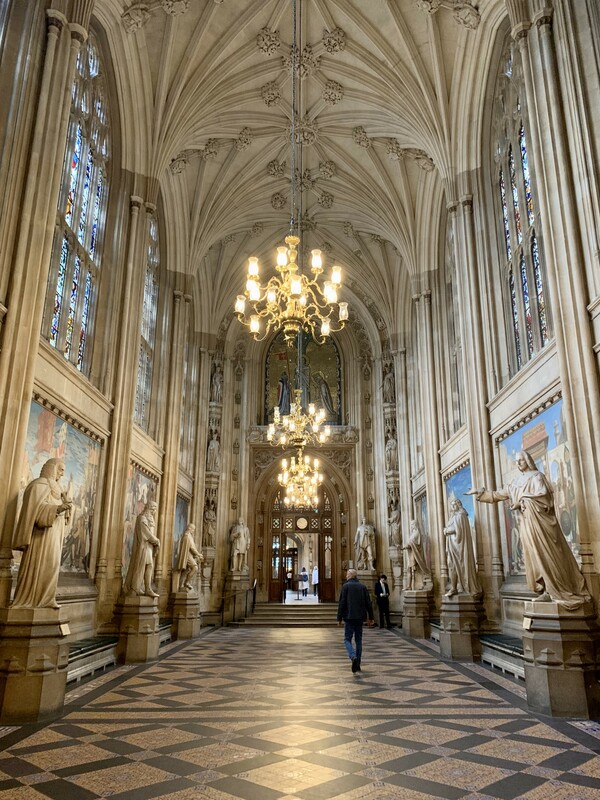
St Stephen's Hall
From Westminster Hall, you ascend the steps to St Stephen's Porch - look up and left and admire New Dawn, a 2016 artwork by Mary Branson to commemorate the 150-year-long campaign for women’s suffrage (the right to vote).
Beneath the artwork is the entrance to the 29 metre long St Stephen's Hall. St Stephen's Hall stands on the site of the Royal Chapel of St Stephen's, where the House of Commons sat until the Chapel was destroyed by the fire of 1834. It's incredibly grand with chandeliers, statues of famous parliamentarians and frescoes on the walls.
The tiled floor features tiny lion motifs - the lions down the centre have their eyes closed, supposedly to protect ladies' modesty, as they floated through the hall in their big hooped skirts.
At one stage women were not permitted beyond St Stephen's.
Once you leave St Stephen's Hall, no photography is officially permitted without a permit.
You may notice a doorway and passage on the right as you walk from Westminster Hall into St Stephen's - this is only accessible to passholders and leads into the House of Lords. More on that below.
Image: St Stephen's Hall early morning with the Central Lobby beyond.
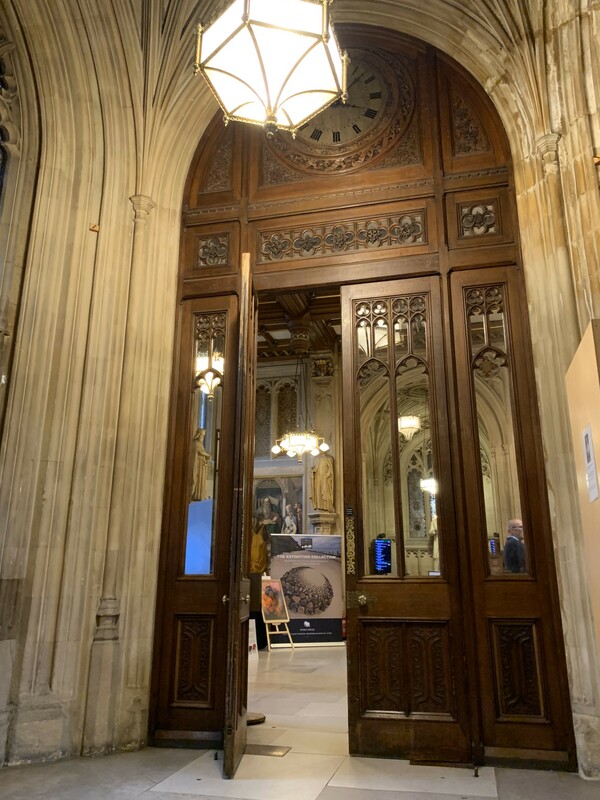
Central Lobby to Upper Waiting Hall
St Stephen's Hall leads to the famous Central Lobby - to the left is the House of Commons, to the right the House of Lords.
There were often television crews filming in the lobby. The busiest day by far was Wednesday at midday for Prime Minister's Questions (PMQs). Apparently there is a waiting list of 2 1/2 years for public tickets. Tickets are free and permit entry to the House of Commons Chamber to watch PMQs - people were queuing on the right hand side all the way down St Stephen's Hall.
Designed by Charles Barry, the grand stone octagonal lobby features the patron saints of Great Britain and Ireland, represented in glass mosaics over the doorways: St. George (South); St. David (North); St. Andrew (East); and St. Patrick (West).
The grand hall features many statues, along with a Parliamentary post office tucked in on the right hand side as you arrive from St Stephen's.
To access the Upper Waiting Hall we needed to cross over the Central Lobby and follow a short corridor to the Lower Waiting Hall on the other side. An impressive long and wide stone staircase with busts of previous Prime Ministers and elaborate frescoes leads you upwards towards the Upper Waiting Hall and Committee Corridor.
Just on the right, as you leave Central Lobby, there's a security desk and beyond it a door, accessible only to passholders. The door reveals a steep stone stairway which leads you down to the Woolsack (pub) - this is the fastest route to a beer following a television interview in the lobby...
Image: Entrance to The Upper Waiting Hall
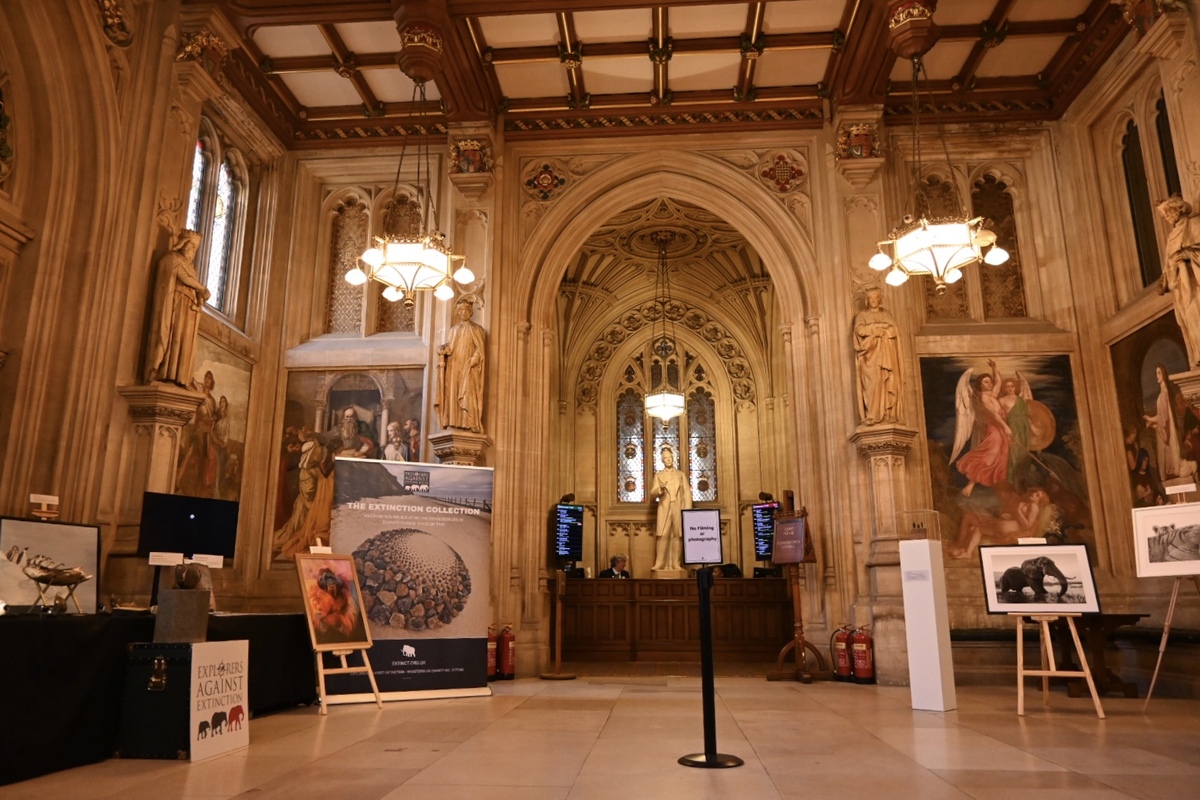
The Committee Corridor
This is a long unbroken corridor which runs the length of the palace. Rooms 5-16 have beautiful views of the River Thames. They vary greatly in size and set up. Committee room 14 is the largest and most familiar from television broadcasts with green chairs bearing the Parliamentary portcullis, benches facing each other, dark wood panelling, green flocked 'Pugin' wallpaper, oil paintings and microphones hanging from the panelled ceiling.
There are additional committee rooms, numbers 17-21, off the Upper Committee Corridor.
The members lift is accessed from Committee Corridor - once downstairs you can get out to the service courtyard or access the river terrace and members' dining rooms. We had to be escorted at all times by a passholder in this part of the Parliamentary estate.
Image: View from within the Upper Waiting Hall looking towards the Committee Corridor which runs left and right beyond the archway. The Upper Committee rooms are accessed from the door to the right of the photo.
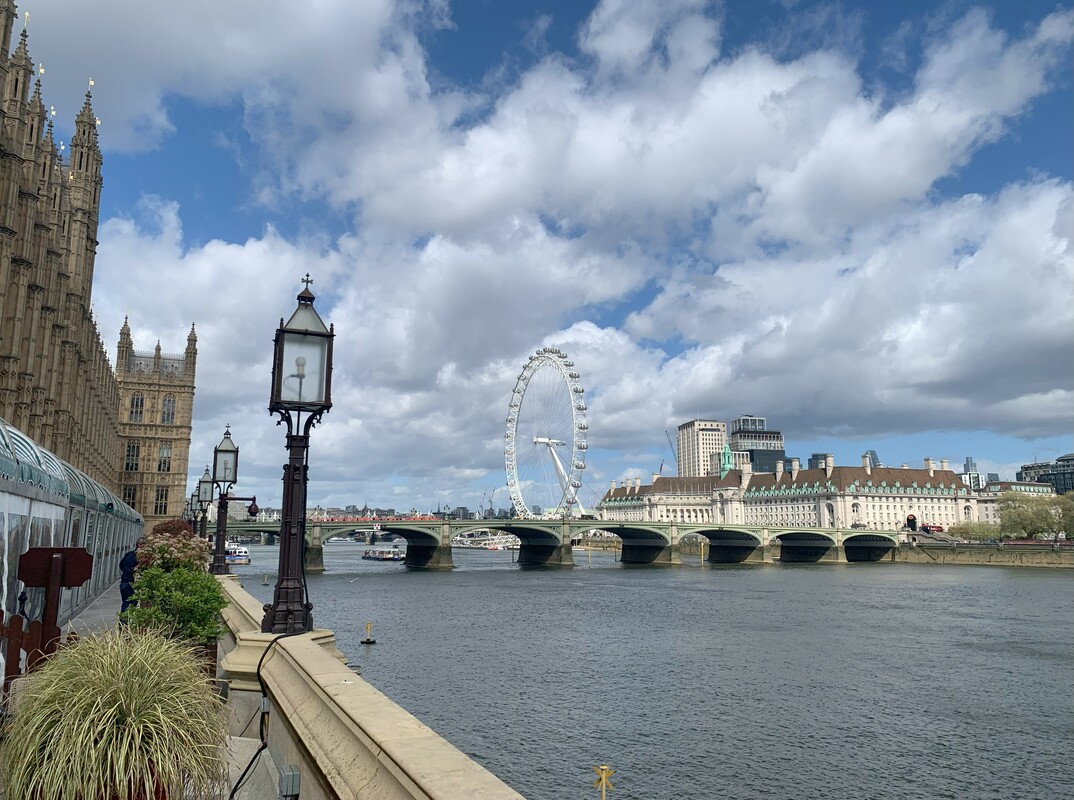
The Stranger's Bar and Dining Room
We had dinner in the Stranger's Dining Room on Monday evening - an opulent space with red flock wallpaper, oil paintings and views across the river - a very grand place which exuded history and felt very special. MPs would scuttle out on hearing the Division Bell before returning minutes later to their dinner.
What did we drink? A suffragette (a potent cocktail made of gin, vermouth, elderflower liquer and garnished with viola flowers) followed by the House of Commons Bordeaux of course... (£27 a bottle).
House of Lords
From St Stephen's Hall, passholders can quickly access the Peers' Private Corridor in the House of Lords. We were lucky to see the Sovereign’s Entrance, the Norman Porch and the doorway through to the Robing Room (it was all locked up unfortunately so we didn't get to go in).
From here the palatial 33.5 m long Royal Gallery stretches out - on the day we visited it was very quiet with just 2 large tables piled high with parliamentary papers for the Lords to collect before attending the Lords Chamber.
When the House is sitting the Royal Gallery is used as a workspace but it also hosts grand state occasions and ceremonies. What a jaw-dropping place!
We also visited the small anteroom between the Royal Gallery and the Lords Chamber - the Prince's Chamber - this was not too shabby either. The room is dominated by portraits of Henry VIII and his wives. There is also a large white marble statue of Queen Victoria. The Prince's Chamber provides a convenient meeting place for members as it is next door to the Lords Chamber. The original room was destroyed by fire in 1834. Pugin re-designed and restored the interiors in the mid 19th Century.
At this point the maze of rooms and corridors becomes quite disorientating - we popped out back on the river, passing through the Lord's library on the way (which was quite something...) and then had a quick pit stop at the cafe.
The cafe, to be honest, was more service station than Pret A Manger - a bog standard white bread fishfinger butty was £6.25 accompanied by a glass of Westminster tap water. The cafe has an outdoor terrace with river views. The mouse traps are a special feature of the interior!
There are security beacons in the water all along the river in front of the Palace - you can see these clearly from the bridge. If anything crosses the beacons, then an alarm sounds. Apparently the windows in the buildings opposite (facing the palace) do not open, also for security reasons.
Image: View from Members' terrace across the river
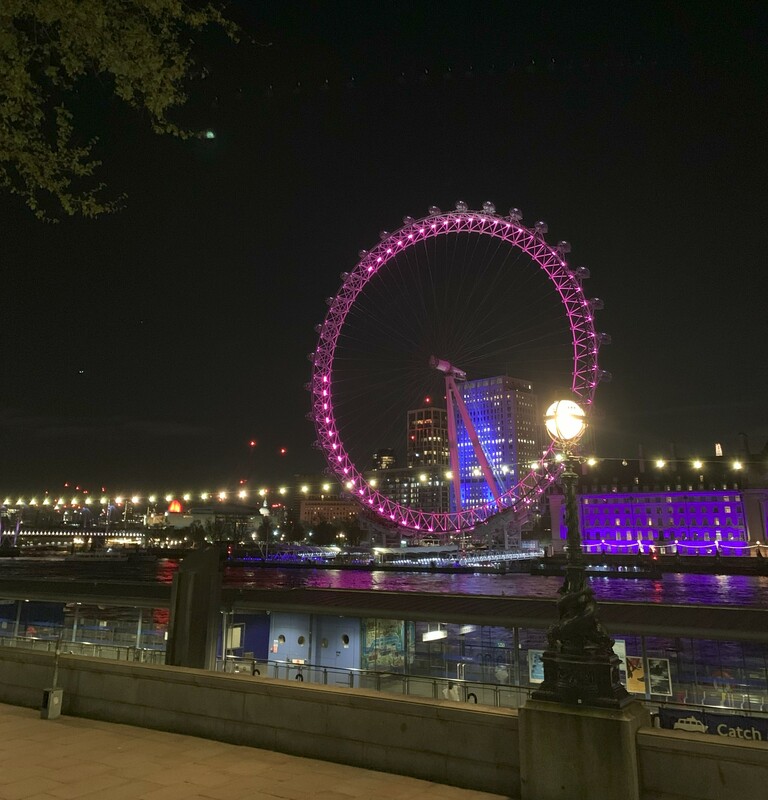
Portcullis House
An underground walkway leads from Westminster, under the road, to Portcullis House. Portcullis House opened in 2001 and when you pop out at the top of the escalator it could not feel more different to the Palace over the road. The main atrium is light and airy, planted with fig trees sitting below a spectacular glass roof akin to Kew Gardens. On the floor above are offices. Below is Westminster tube station. It's a really interesting space as from the outside the building looks gothic with its tall chimneys. The visitor entrance spills out on to Victoria Embankment with views across the river to the London Eye.
Image: exiting Portcullis House on to the Embankment
Below: Some of the official photos taken by us with a permit on Monday
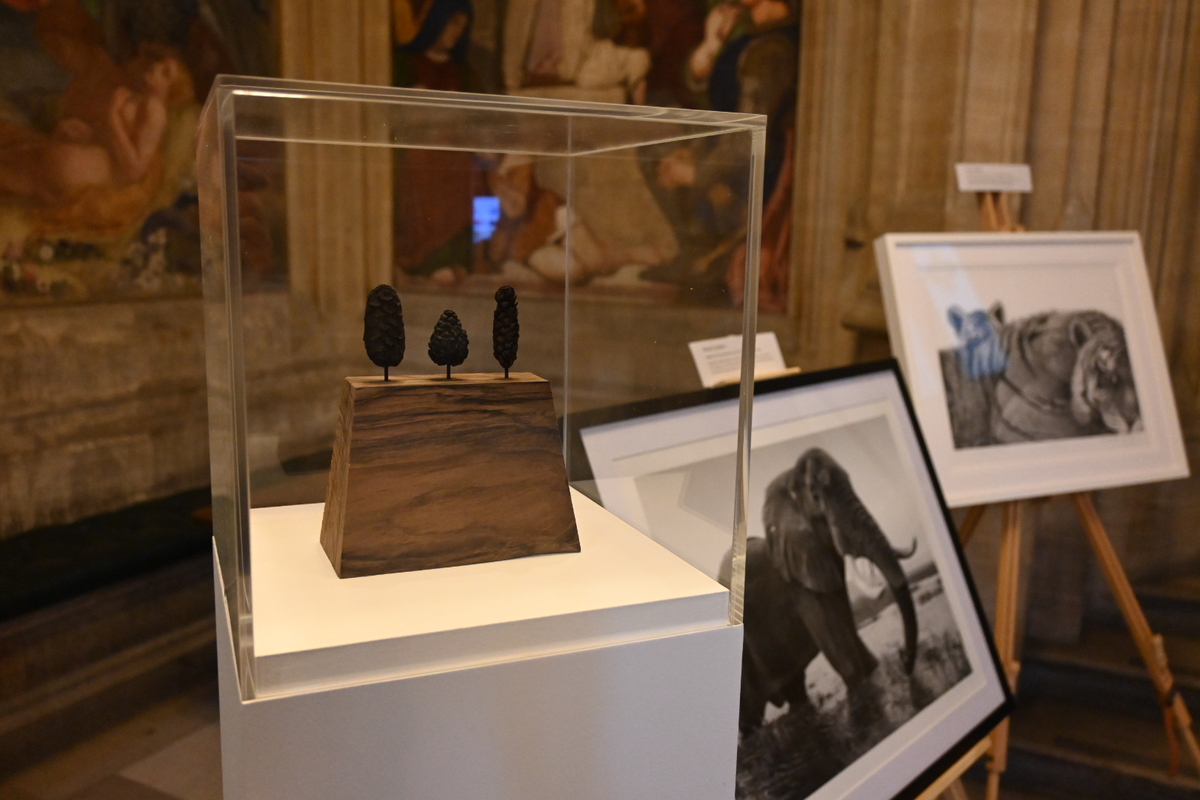
Faraway Trees by David Nash - this beautiful sculpture features c800,000 year old pine cones preserved in the sediments at Happisburgh beach - that's more than c799,000 years older than Westminster Hall - wrap your head around that! (Water Lord by Beverly Joubert and Pride & Joy by Gary Hodges in the background.)
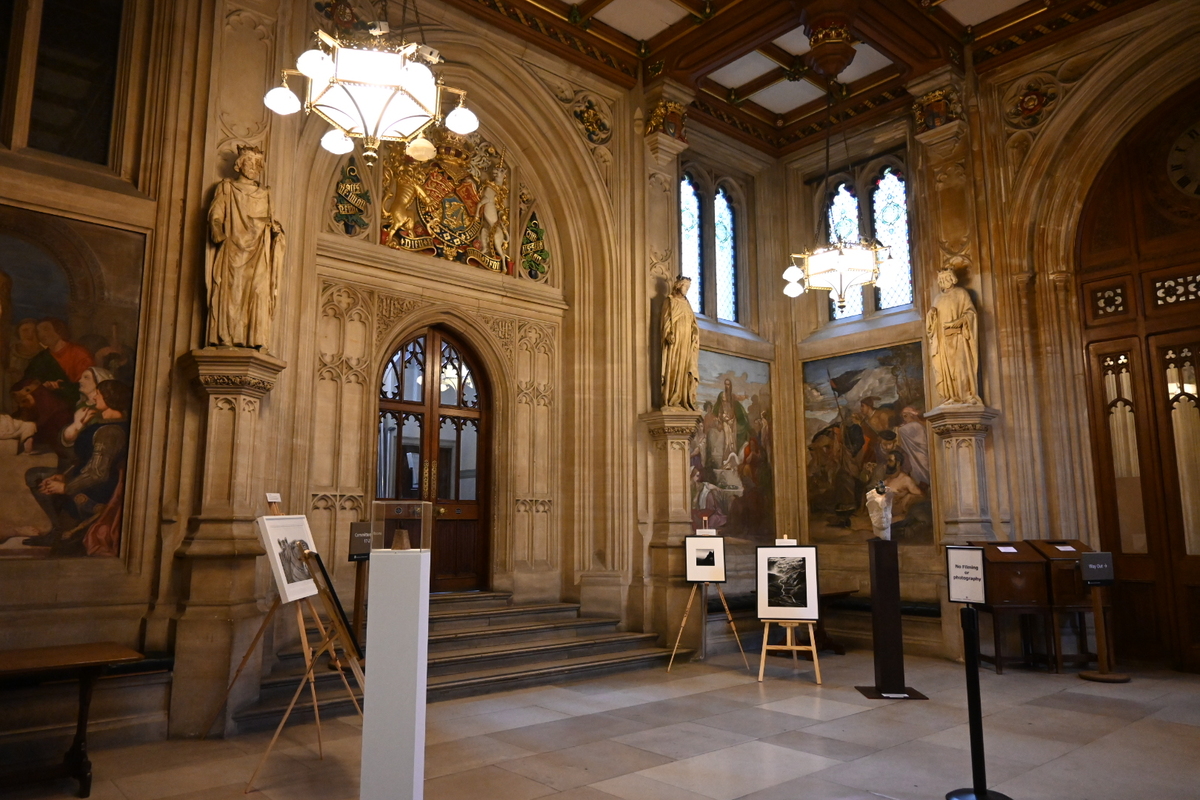
Looking towards the doorway to the Upper Committee Corridor with artworks by Emily Young, Sebastiao Salgado and Michael Kenna to the right of the arch.
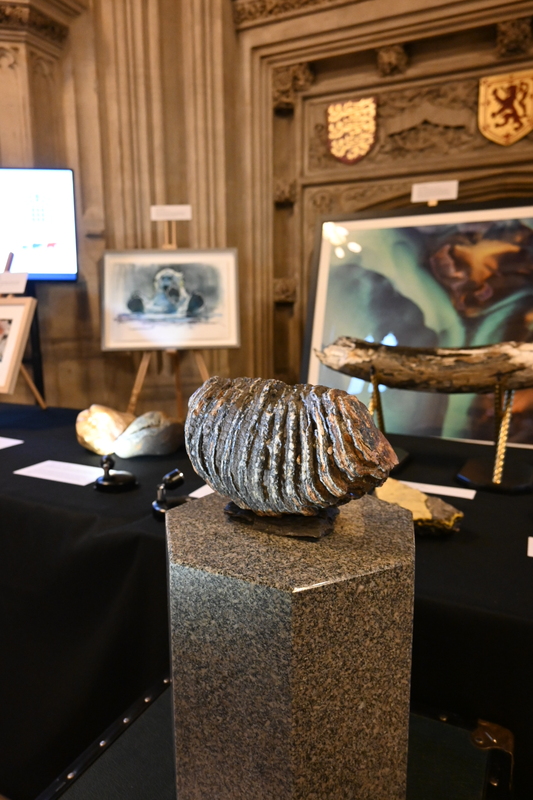
Long in the Tooth (Toothmarks) by Richard Deacon (1 of 4) - tooth of steppe mammoth mounted on partially-fossilised wood from an ancient flooded forest c800,000 years old displayed on a cut and polished seven-sided granite block.
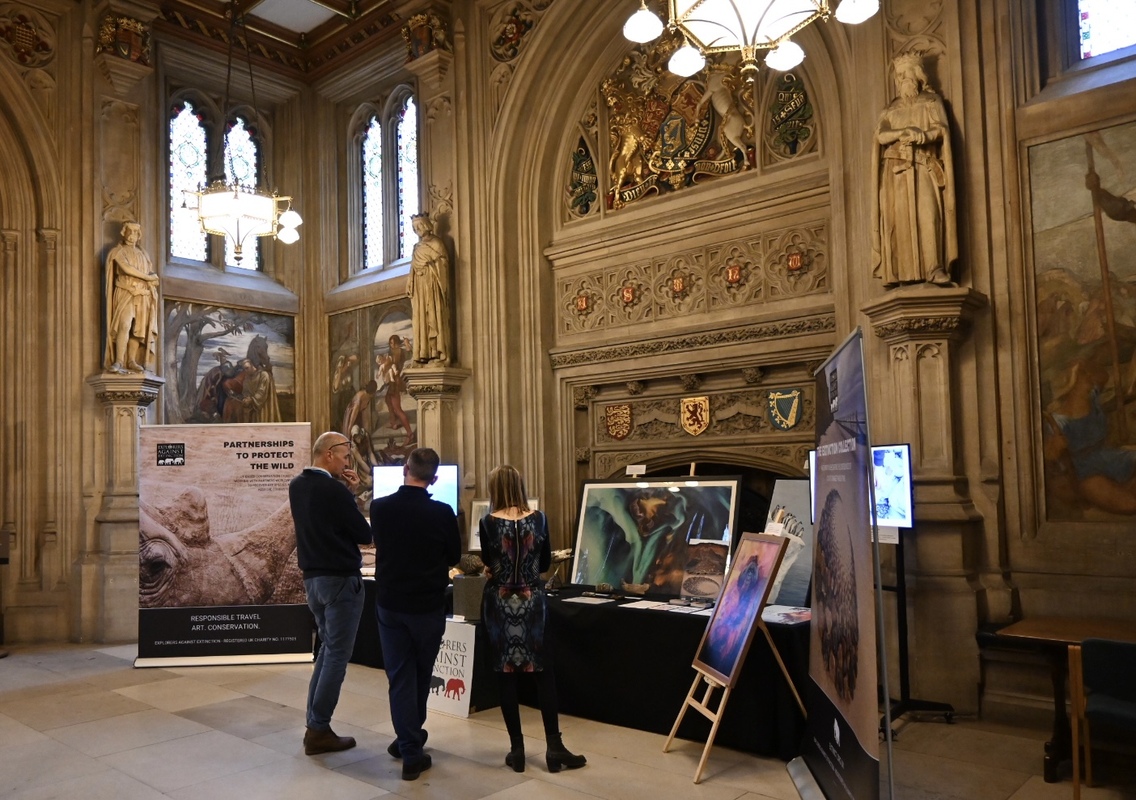
The Upper Waiting Hall - looking towards the fireplace.
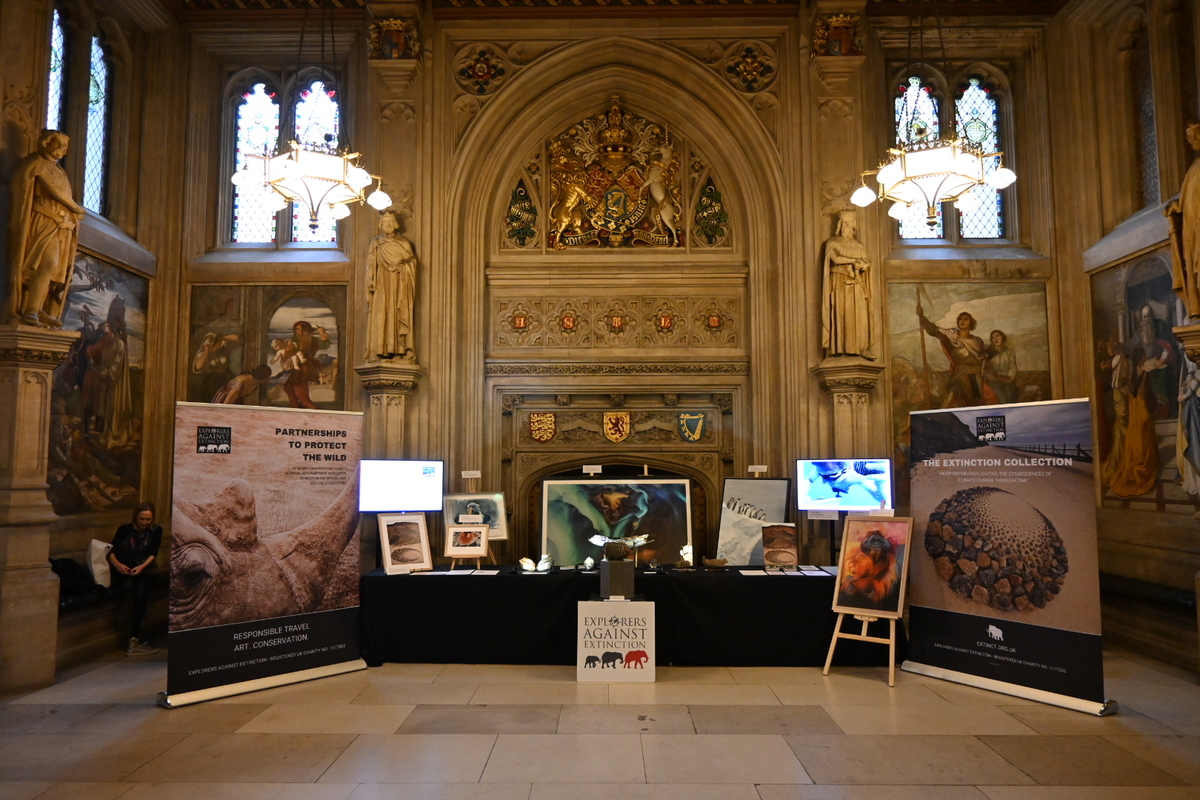
Why were we at Westminster?
To launch The Extinction Collection - a new exhibition for 2024/5 exploring the devastating consequences of climate change through time. By exhibiting at high-profile venues we can raise awareness about our work, put pressure on policy-makers, and build important relationships which may help in the future.
Was it a public exhibition?
This was a private preview for Parliamentarians and their guests.
The position of the exhibition space just off the committee corridor means you get a lot of passing traffic, in particular from the APPG's passing through (All Party Parliamentary Groups). I had written to many of these in advance to let them know we were there. With a workforce of over 7,000 people at Westminster there was no shortage of footfall.
A public exhibition tour will take place later this year.To see the dates and venues announced so far for the UK public tour please visit EVENTS.
Where were we exhibiting?
In the Upper Waiting Hall leading to the Committee Rooms at the Palace of Westminster in London. This area of the Palace is not on the public tour route.
Who did we see?
We pre-arranged a number of appointments with MPs and Peers throughout the week - this proved very valuable. Some MPs breezed through without too much interaction, other than to tell us what wonderful work they had done in conservation - others were more engaged and spent time talking with us and learning about our work and the exhibition.
Of all our appointments and visitors, Sir Roger Gale was particularly helpful and seemed genuinely interested in the exhibition, as was Caroline Lucas.
MPs spotted around the estate include: Ed Davey, Iain Duncan Smith, Grant Schapps, George Galloway, Philip Dunne, Michael Gove, Ed Milliband.

